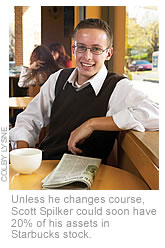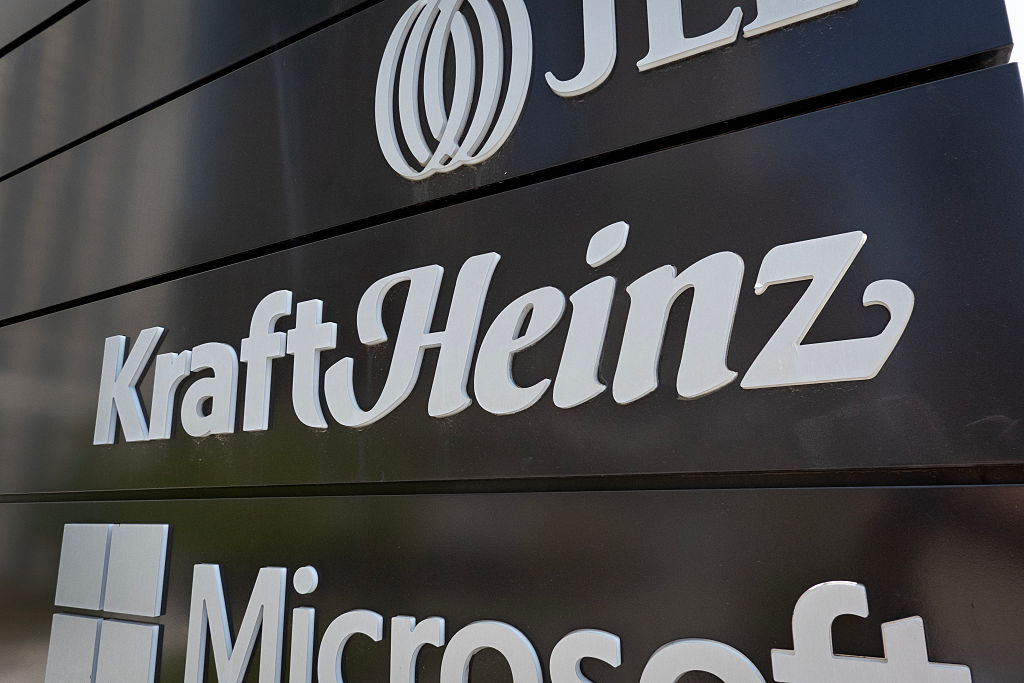The Right Stake in Your Company
Holding too much of the boss's stock can be hazardous to your wealth.

Scott Spilker, a major in international business in his last year of college, works 30 hours a week as a shift manager at a Starbucks in suburban Kansas City. Because he often works past 11 p.m., it's fitting that his preferred beverage is Starbucks coffee -- black. "Sounds kind of lame," he confesses with a laugh. "But it's what I like."
Scott, 21, also has a taste for Starbucks stock. He lives rent-free, with his parents, in Leawood, Kan., so he can afford to participate in the company's savings plans. Late in 2007, he decided to use 10% of his gross monthly pay of $1,400 to buy Starbucks shares, which employees may purchase at a 15% discount to a price that the company sets periodically. Scott is also deferring 4% of his pay to several Vanguard funds in the company's 401(k) plan. For now, Starbucks offers a matching contribution equal to 1% of his salary; that money, too, goes into the funds.

The end result is that Scott invests $2 in Starbucks shares for every $1 he channels into his diversified 401(k). "I'm getting an immediate 15% return," reasons Scott, who has paid an average of $22 for each of his 20 shares. Thank goodness for the employee discount. The stock (symbol SBUX) traded at $23 in mid November, off from $40 a year earlier. Rising dairy and energy costs and sluggish sales growth in the U.S. have pressured the shares.
From just $107.88 $24.99 for Kiplinger Personal Finance
Become a smarter, better informed investor. Subscribe from just $107.88 $24.99, plus get up to 4 Special Issues

Sign up for Kiplinger’s Free Newsletters
Profit and prosper with the best of expert advice on investing, taxes, retirement, personal finance and more - straight to your e-mail.
Profit and prosper with the best of expert advice - straight to your e-mail.
What's right?
Scott, who intends to work full-time for Starbucks after he graduates, figures that about 10% of his holdings are now in the coffee chain. If he sticks with his current program, it won't be long before his allocation to Starbucks hits 20%, unless the shares sink or his funds go wild.
Which raises the question of how much stock is too much in a company that is also your employer. Mary Maginniss, a director of SBSB Financial Consultants, in McLean, Va., says that "15% is the upper boundary," and that even 10% is high. Hugh Smith, director of financial planning for the Welch Group, in Birmingham, Ala., says that 5% is enough and that 10% is pushing things unless you're a senior executive. But there are other issues to consider:
Handcuffs. Are there restrictions on when you can sell your stock? Scott can sell his shares anytime. Unfortunately, lockdown periods remain common, despite the outcry after the Enron scandal. If you face such restrictions, don't rely on the shares for meeting important goals until after you can gain control of them.
Type of company. If you work for a small, fast-growing firm, don't keep more than 5% of your investments in the company, says Smith. He reasons that if the firm flourishes, you'll amass a bundle anyway. Better to be conservative lest the company flop and you lose your job as well as your investment.
Alternatives. Scott's embrace of the 15% discount is logical. But if he puts more money into his 401(k), he'll get immediate tax savings, plus matching money and diversification. Maginniss thinks Scott should reverse his pattern of contributions and put 10% in the 401(k) and 5% in the stock.
Taxes. If Scott were near retirement, he'd have to weigh other issues. If he had adequate income, he could donate shares or leave some to heirs so that they could benefit from the stepped-up tax basis. But if money were tight, it would be appropriate (assuming capital-gains tax rates remain low) to sell some shares and invest the proceeds in income-producing investments.
Stumped by your investments? Write to us at portfoliodoc@kiplinger.com.
Profit and prosper with the best of Kiplinger's advice on investing, taxes, retirement, personal finance and much more. Delivered daily. Enter your email in the box and click Sign Me Up.

Kosnett is the editor of Kiplinger Investing for Income and writes the "Cash in Hand" column for Kiplinger Personal Finance. He is an income-investing expert who covers bonds, real estate investment trusts, oil and gas income deals, dividend stocks and anything else that pays interest and dividends. He joined Kiplinger in 1981 after six years in newspapers, including the Baltimore Sun. He is a 1976 journalism graduate from the Medill School at Northwestern University and completed an executive program at the Carnegie-Mellon University business school in 1978.
-
 Nasdaq Leads as Tech Stages Late-Week Comeback: Stock Market Today
Nasdaq Leads as Tech Stages Late-Week Comeback: Stock Market TodayOracle stock boosted the tech sector on Friday after the company became co-owner of TikTok's U.S. operations.
-
 Disney’s Risky Acceptance of AI Videos
Disney’s Risky Acceptance of AI VideosThe Kiplinger Letter Disney will let fans run wild with AI-generated videos of its top characters. The move highlights the uneasy partnership between AI companies and Hollywood.
-
 Ask the Editor: Itemized Deductions
Ask the Editor: Itemized DeductionsAsk the Editor In this week's Ask the Editor Q&A, Joy Taylor answers questions on itemized deductions claimed on Schedule A of Form 1040
-
 What the Rich Know About Investing That You Don't
What the Rich Know About Investing That You Don'tPeople like Warren Buffett become people like Warren Buffett by following basic rules and being disciplined. Here's how to accumulate real wealth.
-
 How to Invest for Rising Data Integrity Risk
How to Invest for Rising Data Integrity RiskAmid a broad assault on venerable institutions, President Trump has targeted agencies responsible for data critical to markets. How should investors respond?
-
 What Tariffs Mean for Your Sector Exposure
What Tariffs Mean for Your Sector ExposureNew, higher and changing tariffs will ripple through the economy and into share prices for many quarters to come.
-
 How to Invest for Fall Rate Cuts by the Fed
How to Invest for Fall Rate Cuts by the FedThe probability the Fed cuts interest rates by 25 basis points in October is now greater than 90%.
-
 Are Buffett and Berkshire About to Bail on Kraft Heinz Stock?
Are Buffett and Berkshire About to Bail on Kraft Heinz Stock?Warren Buffett and Berkshire Hathaway own a lot of Kraft Heinz stock, so what happens when they decide to sell KHC?
-
 How the Stock Market Performed in the First 6 Months of Trump's Second Term
How the Stock Market Performed in the First 6 Months of Trump's Second TermSix months after President Donald Trump's inauguration, take a look at how the stock market has performed.
-
 Fed Leaves Rates Unchanged: What the Experts Are Saying
Fed Leaves Rates Unchanged: What the Experts Are SayingFederal Reserve As widely expected, the Federal Open Market Committee took a 'wait-and-see' approach toward borrowing costs.
-
 Fed Sees Fewer Rate Cuts in 2025: What the Experts Are Saying
Fed Sees Fewer Rate Cuts in 2025: What the Experts Are SayingFederal Reserve The Federal Reserve cut interest rates as expected, but the future path of borrowing costs became more opaque.